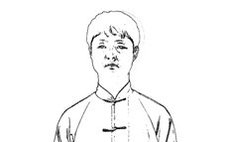Relaxation Qigong was developed in the 1950s by experts at the Shanghai Qigong Therapy Institute to overcome the limitations of simple sitting meditation. It centers on the concept of “relaxation” and is based on texts such as the “Taiqing Qigong Classic” and the “Most Correct Method for Health and Longevity.” This set of techniques combines traditional practices with modern cultural characteristics, ensuring safety, effectiveness, and ease of promotion. During the first national wave of development in the 1950s and 60s, Relaxation Qigong became a representative of Southern Qigong, working alongside Mr. Liu Guizhen’s Internal Nourishing Qigong from the North in practice, teaching, and research, earning accolades in the Qigong community as the “Southern and Northern Twin Jewels.” Over the following decades, Relaxation Qigong has been widely applied in clinical settings, achieving numerous results. Today, this technique is one of the 15 Qigong methods promoted nationwide by the National Administration of Traditional Chinese Medicine and is also one of the five pilot projects for traditional Chinese exercise promoted by the Shanghai Municipal Health Commission and the Municipal Office of Traditional Chinese Medicine.
There are various specific relaxation methods in Relaxation Qigong, among which the most commonly used is the Three-Line Relaxation Method (Gong). Other methods include the Relaxation through Communication Method, Segmental Relaxation Method, Tapping Relaxation Method, Trembling Relaxation Method, and Reverse Relaxation Method.
Theoretical Basis of the Technique: Guided by Meridian Theory
The meridians are pathways through which Qi and blood flow, connecting the organs and communicating internally and externally, as well as linking the upper and lower parts of the body. Their importance is emphasized in the “Lingshu: Meridians,” which states: “The meridians determine life and death, address all diseases, and regulate deficiency and excess; they must be unobstructed.” The theoretical basis of Relaxation Qigong comes from traditional Chinese medicine, particularly Meridian Theory. For instance, the three lines of the Three-Line Relaxation Method, the 27 relaxation points, and the four stopping points are closely related to the meridians and acupoints. The three lines correspond to the sides, front, and back of the body, which are also the pathways of important meridians, such as the Hand Yangming and Hand Taiyin meridians along the sides (arms), the Foot Taiyin and Foot Yangming meridians along the front (head, chest, abdomen), and the Foot Taiyang and Governing Vessel along the back (occiput, neck, lumbar region). The 27 relaxation points and four stopping points are almost all significant acupoints, with the stopping points of the three relaxation lines being Jing points, which are the origins of Qi and blood in the meridians. Focusing on these acupoints has a significant regulatory effect on the flow of Qi and blood in the body. Relaxation Qigong regulates the body’s meridian Qi and blood through physical relaxation, breathing, and mental focus, thereby promoting health and alleviating diseases.
Characteristics of the Technique: Long Exhalation and Short Inhalation with the Mental Recitation of “Relax”
The primary characteristic of the Three-Line Relaxation Method is the long exhalation and short inhalation breathing technique, accompanied by the mental recitation of “Relax” during exhalation. Initially, practitioners use natural breathing, exhaling while mentally reciting “Relax—” and emphasizing a slow, even exhalation without rush. This aims to extend the duration of exhalation, and as practice deepens, a natural pattern of long exhalation and short inhalation develops. During exhalation, one should relax both body and mind, focusing on the feeling of relaxation rather than the sound produced. At first, to concentrate, the sound is relatively clear, but as relaxation deepens, the mental activity gradually decreases, and the sound becomes softer, eventually fading to a mere feeling of “ong,” with no audible sound. At this point, breathing transitions from the usual coarse and erratic state to a deep, slow, fine, and even state of breathing.
From its effects, Relaxation Qigong leans towards a draining method. Traditional Qigong theory holds that inhalation is Yang, which has a tonifying effect and can increase sympathetic nervous system tension; exhalation is Yin, which can drain and reduce sympathetic nervous system tension. Relaxation Qigong emphasizes prolonged exhalation, thus focusing on the draining effect. In the early stages of practice, the sound is clearer, and the draining effect is more pronounced; as one enters a deeper state of tranquility, the sound diminishes until it becomes silent, and the draining effect gradually weakens, leading to a state of calmness.
Challenges of the Technique: Seeking Balance in Contradiction
“Relax” and “Tight” are a pair of contradictions that are dialectically unified in Relaxation Qigong. Firstly, during practice, there is relaxation within tension and tension within relaxation. Practicing Relaxation Qigong does not mean allowing the body to become completely limp, as a limp body, while appearing relaxed, can compress many joints. Even lying flat on a bed, a completely limp body is not conducive to the flow of Qi and blood. Therefore, the relaxation during practice is a state of relaxation with a certain degree of tension, which the ancients referred to as “relaxed but not slack.” Similarly, the sitting and standing postures in Relaxation Qigong require a “correct” posture, which may seem to require tightening the body, but in reality, this “correct” posture is a natural alignment of Qi and blood after relaxation, akin to a tree growing vigorously in sunlight and moisture, displaying a natural and expansive form. It is not a rigid, stiff posture like a puppet, which the ancients referred to as “tight but not stiff.” Secondly, during the relaxation process, relaxation and tension promote and transform into each other. While practicing Relaxation Qigong, concentrating the mind on a specific body part can help eliminate distractions, achieving a state of “one thought replaces myriad thoughts,” gradually reaching a state of relaxation and tranquility in Qigong, and on this basis, perceiving various sensations and changes in the body for self-adjustment to achieve better practice results.
Levels of the Technique: Gradual Deepening of Relaxation
Relaxation itself can be divided into different levels, which we can roughly categorize into three stages: the Relaxation and Stillness Stage, the Relaxation and Communication Stage, and the Relaxation and Emptiness Stage. The levels of relaxation include both physical and psychological aspects, which are interrelated. Firstly, physical relaxation facilitates psychological relaxation, and to achieve physical relaxation, proper posture is necessary, along with some psychological engagement. Insufficient mental focus leads to inadequate relaxation, while excessive mental focus can create mental tension, which is not conducive to relaxation. Therefore, for each practitioner, it is essential to make appropriate self-adjustments based on their self-perception during practice to gradually meet the requirements of relaxation.
The initial requirement for practicing Relaxation Qigong is to achieve a state of physical relaxation and mental calmness, feeling that the entire body, both inside and out, is relaxed and natural, with smooth Qi and blood flow, free of distractions, and a peaceful mind. This marks the entry into the Relaxation and Stillness Stage. With continued practice, one will feel the body gradually loosening; some may experience a layer-by-layer relaxation, while others may feel it loosening in chunks, with the sensation of relaxation gradually spreading to every corner. Some may feel as if they are sitting in water, others may feel like ice melting, and some may feel their body and skeleton slowly separating, eventually leaving only the skeleton, with the rest dissolved, and even the remaining skeleton may dissolve, placing the entire body and mind in a state of subtle presence and absence. These are all manifestations of smooth Qi and blood flow, thus entering the Relaxation and Communication Stage, where the mind becomes even calmer, accompanied by an indescribable joy. Finally, one enters the Relaxation and Emptiness Stage, characterized by a sense of emptiness, where even the subtly present body disappears, and the mind transcends calmness, entering a state of emptiness. It is important to note that this emptiness is not a vacuum or complete silence, but a lively and dynamic state of emptiness. At this point, breathing becomes very slow and subtle, and if one continues to practice, they can ultimately reach the state of the three harmonies. For beginners, achieving the requirements of the Relaxation and Stillness Stage is sufficient; the subsequent Relaxation and Communication and Relaxation and Emptiness stages should be allowed to unfold naturally without deliberate pursuit, as haste can lead to failure.
Methods and Effects of Relaxation Qigong
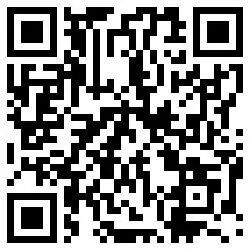
Click the image above to scan the QR code and watch the Qigong video directly.
Relaxation Qigong emphasizes mental focus and guiding Qi flow. This technique is safe and effective, not limited by environmental conditions, and does not require equipment, making it suitable for practice in offices, studies, bedrooms, and parks. The practice time is also flexible, ranging from as short as 10 minutes to as long as one or two hours. Relaxation Qigong includes various relaxation methods, and practitioners can choose one or several based on their current needs. Below, we will describe the specific operation of the Three-Line Relaxation Method as an example.
The Three-Line Relaxation Method divides the body into three lines: the side, front, and back, with each line containing nine relaxation points and one stopping point. During practice, relaxation is performed sequentially along these three lines from top to bottom. The Three-Line Relaxation Method is one of the basic methods for relaxing the body and mind. Beginners practicing this method can concentrate their thoughts, relax their entire body, and relieve fatigue. With long-term adherence to this method, the degree of relaxation will continuously increase, and the effects will become more pronounced, allowing practitioners to feel energized and joyful. The Three-Line Relaxation Method is a static practice, with simple movements and postures, but rich psychological operations that require careful experience during practice.
Common Postures
There are various postures available for practicing Relaxation Qigong, including standing (standing posture), sitting (sitting posture), lying down (lying posture), or walking while practicing (walking posture).
Standing Posture
Stand with legs apart, naturally, at a comfortable width; feet parallel and shoulder-width apart, knees slightly bent, with knees not exceeding the toes, and the hips sitting down as if sitting on a stool. The waist should be extended without arching the back, and the upper body should be upright, with the chest relaxed and the back straight. The head and neck should be aligned. Close your eyes lightly and keep your mouth slightly closed. Let your arms hang naturally, relax your shoulders and elbows, and place your hands at your sides or in front of your body, palms facing inward as if holding a ball (Figure 1), or stack your hands over your lower abdomen (Figure 2).
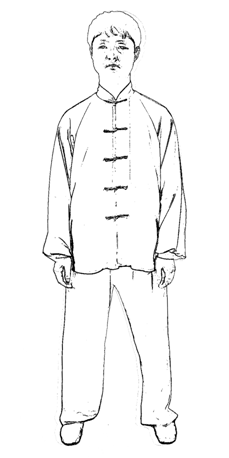
Figure 1
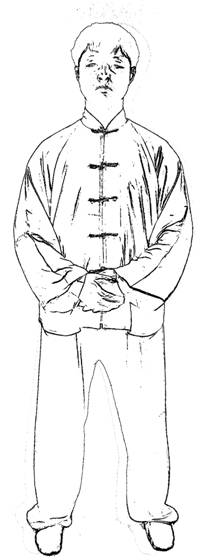
Figure 2
Sitting Posture
Flat Sitting Posture: Sit on the outer third of a stool or chair, not fully sitting down. The height of the stool or chair should be equivalent to the length of the lower leg, with feet parallel and shoulder-width apart, avoiding a bow-legged stance. The knees should be at a 90-degree angle, with thighs parallel to the ground and at a 90-degree angle to the upper body. Keep the waist straight, head upright, chin slightly tucked, chest relaxed, and back straight, with the neck relaxed. Close your eyes lightly and keep your mouth naturally closed, with the upper and lower teeth slightly apart. Let your arms hang naturally, relax your shoulders and elbows, with palms facing down resting on your thighs (Figure 3), or resting flat on your lower abdomen, with elbows naturally bent to keep the armpits open without tightening (Figure 4).
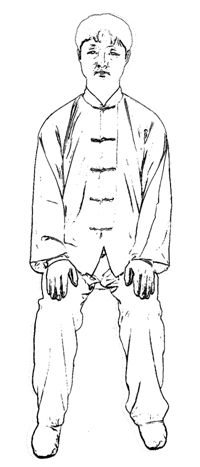
Figure 3
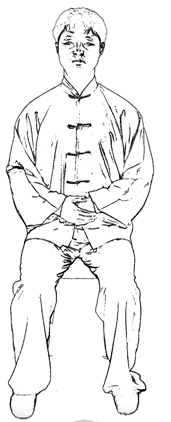
Figure 4
Leaning Sitting Posture
Sit on a bed with your back supported at about a 45-degree angle, keeping your head upright, neck relaxed, and eyes lightly closed. Extend your limbs naturally, with legs apart or together according to personal preference, and let your feet point outward naturally. Let your arms hang naturally at your sides, with palms facing inward, or stack your hands over your lower abdomen.
Lying Posture
There are two lying postures: supine and lateral. In the supine position, lie flat on your back, head straight, eyes lightly closed, and limbs extended naturally, with legs apart or together according to personal preference, and feet pointing outward. Let your arms extend downward, with palms facing inward at your sides (Figure 5).

Figure 5
In the lateral position, lie on your side with your head slightly tucked towards your chest, eyes lightly closed, legs stacked, and knees naturally bent. The upper leg should be bent at a greater angle, with the upper arm palm facing down resting on the hip, and the lower arm bent at the elbow with the palm facing up resting near the ear. Either left or right lateral position is acceptable, but since the heart is on the left side, lying on the left may compress the heart, so the right lateral position is generally preferred (Figure 6).
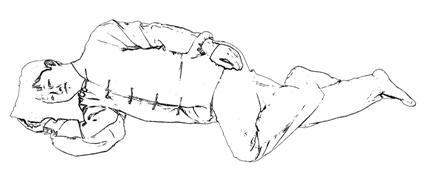
Figure 6
Breathing Techniques
Natural Breathing
This method resembles our usual breathing in a quiet state of life, with a slight focus on exhalation during practice. This breathing is slightly slower than our usual breathing, generally reducing to about 10 breaths per minute or even slower, representing a natural breathing pattern with slight mental focus. This breathing form can be used during the preparation phase, conclusion phase, and while focusing on the lower dantian.
Abdominal Breathing
This method is similar to natural breathing, gradually forming a breathing pattern through long-term practice, characterized by the rise and fall of the abdomen during breathing. Depending on the method of rise and fall, it can be further divided into abdominal breathing and reverse abdominal breathing. If the abdomen rises during inhalation and falls during exhalation, it is called abdominal breathing. If the abdomen falls during inhalation and rises during exhalation, it is called reverse abdominal breathing.
Vocal Breathing
Vocal breathing is a significant feature of Relaxation Qigong. During inhalation, focus your mind on a specific area, and during exhalation, lightly vocalize “Relax—”. As practice deepens and relaxation increases, the sound gradually diminishes, eventually becoming silent.
During this breath adjustment process, the principle of “do not forget, do not force” should be followed, allowing breathing to change towards deep, long, soft, fine, and continuous patterns without deliberately holding the breath or forcing it. Discomfort such as chest tightness, dizziness, or fatigue during practice is often related to improper breath control. Once a certain foundation of breath adjustment is established, the process of breath control may shift from conscious to subconscious. At this point, awareness does not need to focus specifically on breathing but can simply follow it.
Operational Steps of the Technique
Relaxation Qigong consists of three parts: preparation before practice, the main practice, and post-practice actions.
Preparation and Requirements Before Practice
The Three-Line Relaxation Method is a static practice that requires high psychological adaptability, so it is essential to pay attention to preparation and conclusion, avoiding any hasty actions. Proper preparation can reduce distractions during practice, helping to improve the quality of practice and maintain smooth progress. Generally, preparation should be done 5-10 minutes before practice.
1) First, stabilize your emotions and stop previous activities, including work, study, reading, thinking, and entertainment. If feeling too fatigued or agitated, it is advisable to refrain from practicing.
2) The lighting in the practice area should not be too bright, and the air should be ventilated, avoiding direct drafts.
3) The surrounding environment should be kept relatively quiet, generally avoiding loud noises during practice, including phone rings and text message alerts.
4) If there is significant pain or clinical symptoms affecting practice, some symptomatic measures should be taken first.
5) Arrange suitable bedding and seating for practice. A wooden board bed is generally preferable. The height of the chair should be appropriate; if too high, use a footrest; if too low, elevate the chair.
6) If necessary, relieve yourself before practice.
7) Loosen tight clothing such as collars and belts. Clothing should not be too tight or too loose.
Main Practice
It consists of three steps: mental relaxation, focusing on the lower dantian, and swallowing saliva into the abdomen.
Mental Relaxation: The Three-Line Relaxation Method can use natural breathing or abdominal breathing. Inhale while focusing on one area. Exhale while mentally reciting “Relax—”; inhale while focusing on the next area, and exhale while reciting “Relax—”. This cycle continues.
There are two types of mental operations: the first is to listen to the sound of your own recitation of “Relax—”; the second is to focus on the feeling of relaxation in that area while mentally reciting “Relax—”.
The three lines are as follows:
First Line: Both sides of the head → Both sides of the neck → Both shoulders → Both upper arms → Both elbows → Both forearms → Both wrists → Both hands → Ten fingers. Stopping point is Zhongchong (Middle Rushing) point.
Second Line: Face → Front of the neck → Chest → Abdomen → Both thighs (front) → Both knees → Both calves → Both feet → Ten toes. Stopping point is Yinbai (Hidden White) point.
Third Line: Back of the head → Back of the neck → Back → Waist → Back of the thighs → Both knee hollows → Back of the calves → Both heels → Both soles. Stopping point is Yongquan (Gushing Spring) point.
Focusing on the Lower Dantian: After relaxing all areas along the three lines, maintain the previous posture and lightly focus on the lower dantian for 3-4 minutes.
Swallowing Saliva into the Abdomen: Maintain the previous posture. Swallow saliva from the mouth in three sips. Maintain deep, long, soft, and fine breathing. Imagine that the vital energy within the body follows the saliva down to the lower dantian. Swallow gently without force.
Post-Practice Actions
After swallowing saliva, begin to conclude the practice by rubbing your hands together, performing a dry wash of the face, combing your hair, and slowly rotating your neck and shoulders, and moving your waist to transition back to daily life.
Precautions
(1) Adjust the intensity of practice based on the practitioner’s physical characteristics, the current environmental conditions, and the practitioner’s needs.
(2) The postures for practice may vary slightly depending on individual constitution and physical condition. For example, individuals with shoulder periarthritis may find it difficult to relax the affected upper limb, while those with knee injuries may shift their center of gravity towards the healthy side. These are normal phenomena. As relaxation deepens, the body will gradually find the most suitable posture, and breathing will find the most appropriate rhythm. Due to different physical conditions, this state may vary, achieving the realm of “seeking only the spirit’s fulfillment, not the form’s similarity.” The key is to find the most suitable state of relaxation for oneself, rather than pursuing an overly rigid standard, which may lead to tension instead.
(3) Regarding the amount of practice, each individual’s physical condition and tolerance differ, especially for patients, where there may be variations in deficiency and excess. Therefore, it is essential to formulate a reasonable practice amount for different individuals. Excessive practice may lead to over-draining and harm the vital energy; insufficient practice may not sufficiently stimulate and mobilize the body’s vital energy, making it difficult to achieve the practice’s purpose. For beginners, it is advisable to start with one posture for 20 minutes, gradually increasing to 40 minutes, and then to 60 minutes, practicing 1-2 times daily.
(4) Relaxation Qigong can be practiced in four different postures: walking, standing, sitting, and lying down. The walking posture consumes the most energy and promotes the most vigorous Qi and blood flow, but relaxation is more challenging, and beginners may easily lose focus. The standing posture consumes less energy, promotes faster Qi and blood flow, and is easier to relax, but there is a risk of falling. The sitting posture consumes the least energy, promotes slower Qi and blood flow, and is the easiest to relax, making it particularly suitable for beginners. The lying posture consumes the least energy, promotes the slowest Qi and blood flow, and is the easiest to relax, but beginners may feel drowsy and should only use it if elderly, weak, or seriously ill.
(5) When practicing Relaxation Qigong in public places like offices or during thunderstorms, it is advisable not to enter too deep a state of tranquility to avoid disturbances that may cause shock; at home or in a safe environment, one can deepen the state of tranquility for better results.
Applications of the Technique
Relaxation Qigong leans towards a draining method, suitable for many conditions of excess or mixed deficiency and excess. It is generally not advisable for deficiency conditions to avoid the risk of “deficiency on deficiency.” Research has confirmed that Relaxation Qigong is effective for cardiovascular diseases, peptic ulcers, chronic gastritis, chronic enteritis, orthopedic diseases affecting the neck, shoulders, back, waist, and joints, ophthalmological diseases such as glaucoma, rhinitis, and tinnitus, as well as psychiatric conditions like insomnia, depression, and anxiety, and some difficult-to-treat syndromes. In practical applications, it can be performed under the guidance of a physician, following the principles of organs, meridians, and Qi and blood differentiation. It is not advisable for patients with collapse or organ prolapse.
Author: Liu Yafei Hebei Medical Qigong Hospital
New Media Editor: Zhu Luyun
Related Articles
Learn Traditional Chinese Medicine Qigong: Knowledge Part 1 | Ancient Famous Doctors Were Often Proficient in Qigong; You Need to Know the History of TCM Qigong
Learn Traditional Chinese Medicine Qigong: Knowledge Part 2 | Three Treasures of Practice: Calmness, Perseverance, and Insight
Learn Traditional Chinese Medicine Qigong: Knowledge Part 3 | Adjusting Body, Breath, and Mind; The Essence of the Three Harmonies
Learn Traditional Chinese Medicine Qigong: Knowledge Part 4 | The Health Benefits of Qigong Are Mainly Reflected in These Four Aspects
Learn Traditional Chinese Medicine Qigong: Techniques Part 1 | The Five Elements Corresponding to Heaven and Man; Scan to Watch the Technique Video
Learn Traditional Chinese Medicine Qigong: Techniques Part 2 | The Dynamic and Static Combination of Hua Tuo’s Five Animal Play (Part 1)
Learn Traditional Chinese Medicine Qigong: Techniques Part 3 | The Practice and Effects of the Five Animal Play (Part 2)
Learn Traditional Chinese Medicine Qigong: Techniques Part 4 | The Practice and Effects of the Five Animal Play (Part 3)
Learn Traditional Chinese Medicine Qigong: Techniques Part 5 | The Return to Simplicity of the Chao Family’s Guiding Technique
Learn Traditional Chinese Medicine Qigong: Techniques Part 6 | The Practice and Effects of the Chao Family’s Guiding Technique (Part 2)
Learn Traditional Chinese Medicine Qigong: Techniques Part 7 | The Integration of Form and Spirit in Internal Nourishing Qigong
Learn Traditional Chinese Medicine Qigong: Techniques Part 8 | The Practice and Effects of the “Yijinjing” (Changing Tendons and Circulating Qi Method) (Part 2)
Learn Traditional Chinese Medicine Qigong: Techniques Part 9 | The Practice and Effects of the “Yijinjing” (Changing Tendons and Circulating Qi Method) (Part 3)
Learn Traditional Chinese Medicine Qigong: Techniques Part 10 | The Practice and Effects of the “Yijinjing” (Changing Tendons and Circulating Qi Method) (Part 4)
Content Collaboration: 010-84249009 ext. 6305
or add WeChat 251693518
Business Cooperation: 18500879979
WeChat Submission Email:[email protected]
(Articles focus on viewpoints, policies, academic discussions, and TCM culture, requiring original submissions; please leave your name, organization, and contact information in the email.)
Copyright Statement:This article is an original work of the “China Traditional Chinese Medicine Newspaper” (WeChat ID: cntcm1989). Unauthorized reproduction is prohibited. Click the lower left corner “Read the Original” to obtain authorization.

